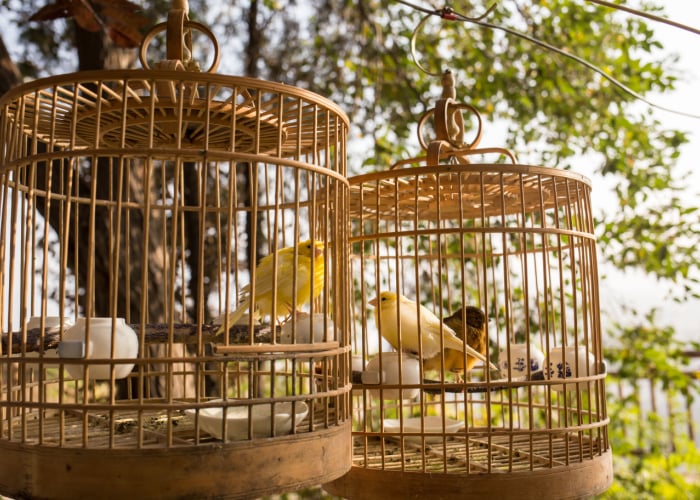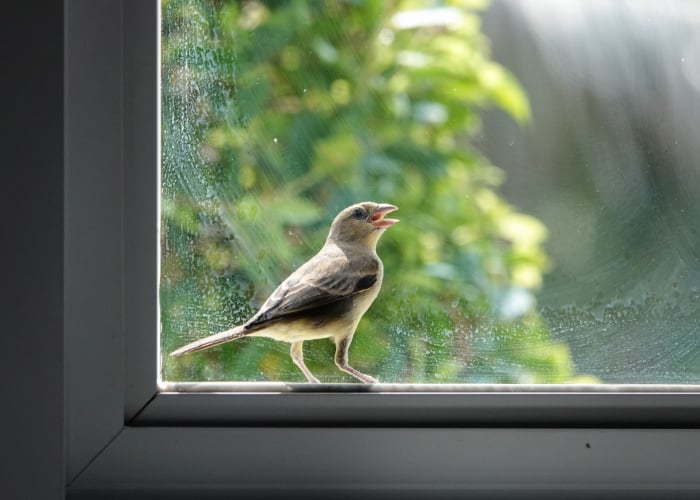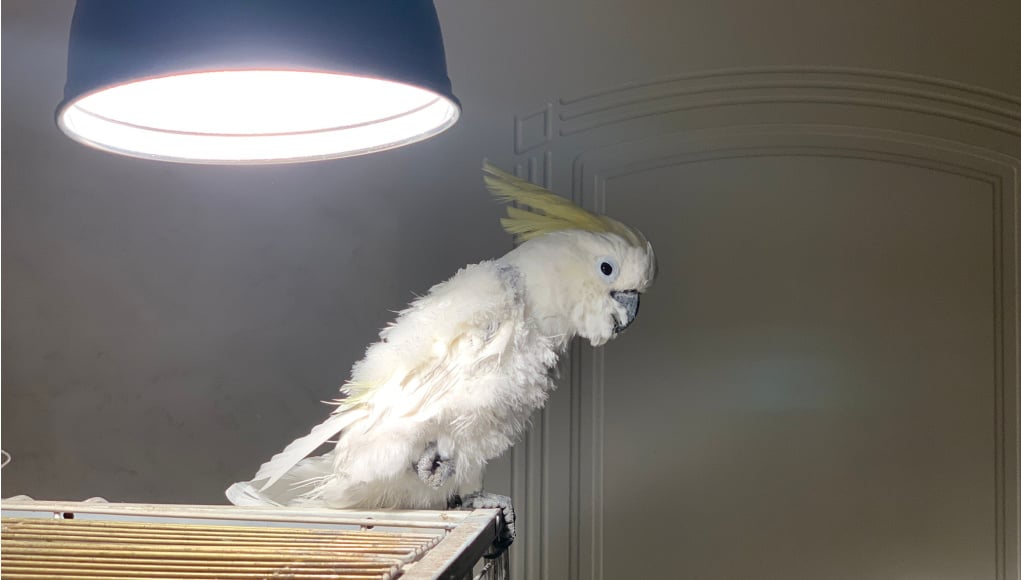Did you know birds have sharper vision than humans, and they can see UV lights from the sun?
What’s even crazier is that human lightings are hundreds or thousand folds dimmer than the natural light they’re used to in the wild.
That’s why our avian creatures need supplemental bird lighting, especially if they’re kept indoors.
Otherwise, they may become lethargic, have a poor appetite, or have trouble recognizing objects around them.
But with all the marketing gimmicks nowadays about the so-called bird lighting and many online options, how can you choose the right light for a bird cage?
In this article, we’ll discuss:
- the importance of lighting for birds’ physiological and psychological health
- the types of effective specialist lamps or lights for bird cages
- the factors you need to consider before purchasing a bird light
- and how to use it to avoid eye damage on birds
So, if you’re a new avian keeper looking for the best bird lighting, this guide will surely be beneficial for you.
This can help you gain insight into aviary lighting and make wise purchasing decisions.

Why Is Bird Lighting Important?
Light is crucial for birds because it affects their physical health and behaviors.
Light also influences avian’s offspring fitnessas well as embryo development.
Furthermore, birds need lighting to unleash their supervision and truly enjoy nature and life.
But there’s so much more to that.
So, join us as we uncover the reasons why your avian creatures need sufficient lighting.
For Better Vision
Birds are among the most visually-oriented animals.
In fact, they have one of, if not the most sophisticated visual systems in nature, the largest eyes among animals relative to their size, and the highest brain proportion dedicated to their vision.
So, they see colors better than humans and process images faster than us.
However, they need light to support and use this amazing visual machinery to analyze their food, identify their flock mates, detect predators, and regulate their daily cycles, including the circadian rhythm.
The main source of light for birds is none other than the sunlight.
However, most of the time, caged birds can’t access sunlight.
And even if we provide light through standard home lighting, it’s still not enough.
It’s either too dim, red, or a poor color spectrum.
For Better Extraocular Photoreception
Aside from their vision, birds’harderianand pineal glands, which control migration, reproduction, molting, and sleep cycles, also react to light.
And these glands may suffer if your bird doesn’t receive adequate light and UV rays.
For Vitamin D3 Production
Birds also need light and UV rays, specifically the UV-B, to produce their own Vitamin D3 safely and self-regulated.
This vitamin also affects your feathery friend’s hormonal balance and organ, skin, and feather health.
And even if you place their cage near a window, they still won’t receive enough sunlight because modern windows filter out UVA and UVB rays.
What will happen if your birds don’t receive enough sunlight, which provides UVA and UVB rays?
Effects of Light Deficiency on Birds:
- lethargy
- poor appetite
- phobias and difficulty in recognizing objects and detecting dangers
- aggression
- stress
- feather plucking
- territoriality
- and undesirable reproductive or breeding behavior like chronic egg laying
To compensate for those shortcomings, you can purchase bird lightings that provideUV-AandUV-Band stimulateVitamin D3 production.
Type of Bird Lighting For Pet Birds
Each type of lighting is different, and not all can fulfill your bird’s needs.
So, you need to be picky when choosing bird lighting.
Some brands label their products “full-spectrum” or “daylight lamps,” even if they cannot project UV.
Furthermore, they can cause corneal scarring when placed too close to a bird cage.
And full spectrum UVB light bulbs only produce for about six months, so they aren’t that beneficial and long-lasting for your long-living birds.
That’s why it’s best to use full-spectrum specialist lamps or lighting designed specifically for birds.
The common types of specialist bird lamps ideal forbird cagesare:
1. High Output T5 or HO-T5
These lamps are 16mm (5/8th inch) in diameter. That’s why they’re easy to hide and conceal.
They utilize the latest technology and can be found in standard and high-output forms.
HO-T5 lights are guaranteed flicker-free, producing about twice the amount of light per watt used in T8 lamps.
That means more photons per watt, brighter and more powerful light, and wider UV reach.
This kind of bird lighting is perfect for flights and large cages.
2. High Output T5 Power Compacts
This kind of lighting utilizes the same technology as the previous T5 bulb.
It’s an 8-watt light with a 5/8th inch diameter and 12” length.
It’s shorter than HO-T5 and has two tubes that are placed side by side in a lamp holder.
They can be installed into a reflector of the “flood” type and emit a clear, bright light.
3. Standard output T8 or SO-T8
This is a low-output linear light with a 1in (2.5cm) diameter, and the first of its kind was first developed in 1999.
It flickers slowly when used with magnetic ballasts but digital ballasts can eliminate this problem.
This bird lighting is gentle, effective, and fit for flights and banks of small bird cages.
4. Standard Output T5 or SO-T5
These thin lights measure the same diameter as the HO-T5 and are also flicker-free.
Furthermore, their compact design makes them easy to mount in breeding cages with small spaces.
5. E27 Compact
These screw-in lamps include internal digital ballasts and are flicker-free.
They fit above a cage and are very simple to use.
However, these lamps had several designs and quality problems throughout the years.
The most recent design, which incorporates a “3 linear loop” glass structure to maximize glass area, has been completely updated.
However, you must avoid low-quality E27 lights and those with spiral designs.
6. Zoological Lamp
This type of birds lighting can be a multi-lamp fitting that utilizes the lamps above and arrange in large groups to accommodate larger zoo cages.
These are usually not suitable for private bird keepers.
Now you may find those types of specialist lamps for reptiles online, but be careful when purchasing because birds and reptiles have different needs.
You may damage your bird’s eyes and skin if you use lighting that emits too much UVA and UVB.
So how can you choose the right birdcage light bulb or lamp?
Let’s dive deeper into that below.

What to Consider When Choosing Bird Lighting
Many bird lighting manufacturers today label their products as ‘full-spectrum’ or ‘daylight’ lamps, whether they’re tungsten, fluorescent, or LED.
But these materials don’t produce UV and won’t be truly beneficial for your avian pets.
So, before purchasing bird lighting, you must consider the following factors to find thebest bird cagelights and ensure your money won’t go to waste.
Light
There are many aspects you need to consider about light.
So, in this section, we’ll dig deeper into them to ensure you make wise purchasing decisions.
Bird Lighting’s Brightness
Birds need sufficient lighting to enhance their perception of nature.
Studies have shown that our feather friends need5 to 20 timesmore light than humans do to see color.
However, most of the lighting we use is hundreds or thousands of times dimmer than the tropical sun they’re used to.
In fact, the standard living room lighting is 8 times dimmer than sunset and sunrise.
Therefore, most of our lights are not bright enough to support your avian’s spectacular vision.
Since our eyes can barely recognize the difference in brightness, let’s consult the numbers to grasp better the brightness we and the birds perceive.
The brightness of light over an area is measured inlux, while the light sources’ brightness is measured inlumens.
The brightness of the sun during sunrise is 400 lux, while at midday, it reaches about 130,000 lux.
On the other hand, the brightest parts of our house, like the kitchen, are just about 300 lux.
Bird Lighting Spectrum
Another factor worth considering when choosing bird lighting is the lamp’s color rendering index or CRI.
Humans only have three color receptors, while birds have four, which are more precise than ours.
It allows the birds to see billions of colors, whereas humans can only perceive around 7 million.
They also see the light faster than we do.
And while we perceive light from bulbs as solid, they appear to be flickering on birds because the light that hits our eyes in waves is not fast enough to be solid for them.
That’s irritating and disorienting for birds and often causes them to act cranky and agitated.
So how should you choose a bird lighting that appears solid to our feathery friends?
Well, your chosen bulb must have a highColor Rendering Index or CRI,这表明光波发射的速度by the bulb.
The perfect CRI is 100, which reflects the sunlight at midday, but birds begin perceiving light as solid at a CRI 0f 91.
Most indoor lightings we use only have a CRI of 60 or 70. So, you must choose a bulb with a CRI of 91.
Many full-spectrum light bulbs meet this requirement, as well as photography lights.
Color Temperature
Regarding color temperature, red is the coolest, while blue is the hottest because it has ashorter wavelengthand is often measured inKelvin.
Birds thrive under the sun’s color temperature of 5000K in tropical latitudes.
So, if you have tropical birds, you must provide them a bulb lighting with a temperature landing between 5000K and 5700K.
Color temperatures hotter than that (bluer) can cause stress andfeather plucking,while those lower than that range(redder) can lead to undesirable breeding behaviors.
Bird Lighting’s UltraViolet Support
Birds can perceive 200 times more colors and color combinations than humans, and one of the things that allow them to do that is their innate ability to see ultraviolet light.
They use this UV vision to recognize their flock mates and see nutrients in their food.
They can even see oils, vitamins, minerals, amino acids, and sugars!
But as said earlier, most modern windows block UV rays, and so does most household lighting.
Although birds don’t need much UV to support their vision, it’d still help your feathery friends.
However, it must not exceed natural sunlight, which is 5% UV content, of which only 0.1% is UV-B (the high-energy light with a short wavelength of 280-315 nm).
Why?
Too much UV-B can cause sunburn, skin cancer, and cataracts in humans and animals.
Cost
Bird lightings that produce natural color and high CRI are made of rare earth phosphors and specialist crystal glass.
That’s why these kinds of light are expensive.
Cheap lamps usually utilize cheaper phosphor mix, don’t provide UV, or are unnaturally balanced.
So, while they’re cheaper, your bird can’t benefit from them because they can’t affect the bird’s health and well-being in a positive way.
Installation
另一个常见的因素值得考虑的决定ing bird lighting is the ease of assembly and installation.
Not all people are skilled in building stuff.
So if you’re not a DIY-er, it’s best to choose those that are easy to set up and install to avoid stress and confusion.
How to Use Bird Lighting and the Proper Positioning
Proper positioning is important in bird lighting because if they’re installed too close to a bird, it might suffer from sunburn and eye damage.
The risk is especially higher if the bird’s lighting is too close and has UV, and your bird can’t move away from the light’s direction.
If the bird’s light shines on the side, that can only increase the risk of glare-related discomfort and damage.
But if you’d place it too far away from the cage, it will not impact yourbird’s health and body, although it can help set the natural day and night rhythm.
Most specialist bird lamps are designed to be installed 10 to 15” above the bird’s head.
If you place the birds lighting at the correct position and distance, your bird can highly benefit from it.
When to Use a Bird Lighting
Birds outdoors don’t require additional lighting because they can enjoy the sunlight, but those indoors need supplemental lighting daily.
Why?
Because these feathery creatures need UVA and UVB rays to keep their body, feathers, and mind healthy.
They won’t be able to receive them if they live indoors because even if you place them near the window, most windows filter UV lights today.
FAQs About Bird Lighting
We also compiled other common questions about the best lights for birds to help you gain more insights into led lights for bird cages.
What is the best lighting for a birdcage?
The bird lights must have a CRI or color rendering index of 93 or above to ensure it does not flicker.
On top of that, it must offer UVA and UVB to stimulate vitamin D-3 production in avians.
What color light is best for birds?
理想的色温热带鸟类between 5000K and 5700K.
Too much can cause behavioral problems like stress and feather plucking.
Are LED lights OK for birds?
Ordinary LED lights aren’t effective in supporting your avian’s supervision because most of them are too dim for birds.
Furthermore, these lights don’t provide UVA and UVB, which are necessary for your bird’s health.
Do birds prefer light or dark?
Birds prefer light during the day but still need time to sleep in the dark at nighttime since these creatures need around 10 to 12 hours of sleep.
But birds with frequentnight frightneed low-level lighting at night.
Can you put LED lights in a birdcage?
You can as long as it’s a full spectrum light that meets the bird’s brightness, CRI and UVA, and UVB requirements.
In fact, LED lights are easy to install on top of most bird cages.
What type of light do birds need?
All birds need natural sunlight to stimulate their vitamin D production, maintain hormonal balance, and skin and feather health.
Birds that must be kept indoors can’t benefit from it, so they need full-spectrum UVB light that emulates natural light.
Are birds sensitive to bright light?
Birds have supervision, so they need brighter lights but are also susceptible to overexposure and glare.
Furthermore, too much light can overwhelm your avian creatures and cause undesirable behaviors and stress.
Can I put a light in my birdcage?
You can put a light, but it should be fitter 10 to 15” above the bird’s head.
This way, it wouldn’t be too close, and you can save your bird from eye damage and discomfort.
Do birds hate UV light?
Despite needing UV light for hormonal balance, skin, and feather health, too much UV can damage a bird’s vision and cause stress.
So while it’s necessary, too much can do more bad than good.
What is the best lighting for parrots?
Nothing beats natural daylight for parrots because it provides optimal lighting for birds.
But if you need to put your avian friend indoors, you may need to provide full spectrum lighting as a substitute for natural light.

Final Thoughts About Choosing Bird Lighting
You may find hundreds or thousands of led lights for birds online.
But you need to make sure you choose one that meets your bird’s requirements, as stated earlier.
Adorning a bird cage with led lights may be fun, but it’s not beneficial for your bird since it doesn’t produce enough light and UVA and UVB.
The best bird cage lighting must provide enough brightness of more than 400 lux, CRI of 91, color temperature of 5000K and 5700K, and UV content not exceeding 5%.
Our go-to bird lighting is the High Output T5 or HO-T5 specialist kind of lamp because it contains all the latest technology and benefits a bird needs.
But if you have smaller cages, you can also opt for a shorter power compact HO-T5 because it’s as clear and bright as the standard one.
And that’s a wrap for this guide for bird light.
We hope this will be helpful and handy for you as you search for the best bird lights for pet birds you adore.
If you need more birdcage accessory ideas, check out the article below.
